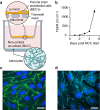Polarized α-synuclein trafficking and transcytosis across brain endothelial cells via Rab7-decorated carriers
- PMID: 35637478
- PMCID: PMC9150364
- DOI: 10.1186/s12987-022-00334-y
Polarized α-synuclein trafficking and transcytosis across brain endothelial cells via Rab7-decorated carriers
Abstract
Parkinson's disease is mainly caused by aggregation of α-synuclein (α-syn) in the brain. Exchange of α-syn between the brain and peripheral tissues could have important pathophysiological and therapeutic implications, but the trafficking mechanism of α-syn across the blood brain-barrier (BBB) remains unclear. In this study, we therefore investigated uptake and transport mechanisms of α-syn monomers and oligomers across an in vitro BBB model system. Both α-syn monomers and oligomers were internalized by primary brain endothelial cells, with increased restriction of oligomeric over monomeric transport. To enlighten the trafficking route of monomeric α-syn in brain endothelial cells, we investigated co-localization of α-syn and intracellular markers of vesicular transport. Here, we observed the highest colocalization with clathrin, Rab7 and VPS35, suggesting a clathrin-dependent internalization, preferentially followed by a late endosome retromer-connected trafficking pathway. Furthermore, STED microscopy revealed monomeric α-syn trafficking via Rab7-decorated carriers. Knockdown of Caveolin1, VPS35, and Rab7 using siRNA did not affect monomeric α-syn uptake into endothelial cells. However, it significantly reduced transcytosis of monomeric α-syn in the luminal-abluminal direction, suggesting a polarized regulation of monomeric α-syn vesicular transport. Our findings suggest a direct role for Rab7 in polarized trafficking of monomeric α-syn across BBB endothelium, and the potential of Rab7 directed trafficking to constitute a target pathway for new therapeutic strategies against Parkinson's disease and related synucleinopathies.
Keywords: Brain endothelial cells and blood brain barrier; Parkinson’s disease; Polarization trap; Rab7; Retromer; Transcytosis; α-synuclein.
© 2022. The Author(s).
Conflict of interest statement
The authors declare no competing interests.
Figures






Similar articles
-
Transmission of α-synuclein-containing erythrocyte-derived extracellular vesicles across the blood-brain barrier via adsorptive mediated transcytosis: another mechanism for initiation and progression of Parkinson's disease?Acta Neuropathol Commun. 2017 Sep 13;5(1):71. doi: 10.1186/s40478-017-0470-4. Acta Neuropathol Commun. 2017. PMID: 28903781 Free PMC article.
-
Astrocytic VEGFA: An essential mediator in blood-brain-barrier disruption in Parkinson's disease.Glia. 2022 Feb;70(2):337-353. doi: 10.1002/glia.24109. Epub 2021 Oct 29. Glia. 2022. PMID: 34713920
-
LRP1 is a neuronal receptor for α-synuclein uptake and spread.Mol Neurodegener. 2022 Sep 2;17(1):57. doi: 10.1186/s13024-022-00560-w. Mol Neurodegener. 2022. PMID: 36056345 Free PMC article.
-
α-Synuclein Trafficking in Parkinson's Disease: Insights From Fly and Mouse Models.ASN Neuro. 2018 Jan-Dec;10:1759091418812587. doi: 10.1177/1759091418812587. ASN Neuro. 2018. PMID: 30482039 Free PMC article. Review.
-
Neurotoxic conversion of beta-synuclein: a novel approach to generate a transgenic mouse model of synucleinopathies?J Neurol. 2009 Aug;256 Suppl 3:286-92. doi: 10.1007/s00415-009-5246-8. J Neurol. 2009. PMID: 19711118 Review.
Cited by
-
Mucopolysaccharidoses and the blood-brain barrier.Fluids Barriers CNS. 2022 Sep 19;19(1):76. doi: 10.1186/s12987-022-00373-5. Fluids Barriers CNS. 2022. PMID: 36117162 Free PMC article. Review.
-
An AAV capsid reprogrammed to bind human Transferrin Receptor mediates brain-wide gene delivery.bioRxiv [Preprint]. 2023 Dec 22:2023.12.20.572615. doi: 10.1101/2023.12.20.572615. bioRxiv. 2023. Update in: Science. 2024 Jun 14;384(6701):1220-1227. doi: 10.1126/science.adm8386. PMID: 38187643 Free PMC article. Updated. Preprint.
-
The cervical lymph node contributes to peripheral inflammation related to Parkinson's disease.J Neuroinflammation. 2023 Apr 10;20(1):93. doi: 10.1186/s12974-023-02770-5. J Neuroinflammation. 2023. PMID: 37038192 Free PMC article.
-
The role of transcytosis in the blood-retina barrier: from pathophysiological functions to drug delivery.Front Pharmacol. 2025 Apr 16;16:1565382. doi: 10.3389/fphar.2025.1565382. eCollection 2025. Front Pharmacol. 2025. PMID: 40308764 Free PMC article. Review.
-
Blood-brain barrier alterations and their impact on Parkinson's disease pathogenesis and therapy.Transl Neurodegener. 2024 Jul 29;13(1):37. doi: 10.1186/s40035-024-00430-z. Transl Neurodegener. 2024. PMID: 39075566 Free PMC article. Review.
References
MeSH terms
Substances
Grants and funding
LinkOut - more resources
Full Text Sources
Other Literature Sources
Medical
Miscellaneous

